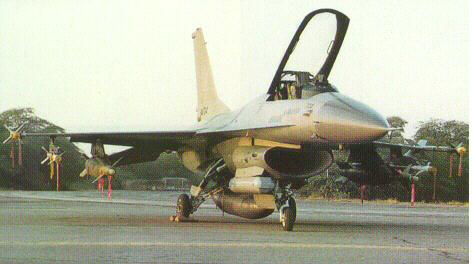

 Introduction: The F-16 Fighting Falcon was inducted into the PAF in 1983. The initial order was for 40 Block 15 aircraft (28 F-16As and 12 F-16Bs). The F-16A is a single-seat air combat fighter while the F-16B is a dual-seat combat capable fighter trainer. The F-16 is a true multi-mission aircraft and can carry up to 15,200 lb. of bombs, missiles and rockets. It presently equips No. 9 and No. 11 (OCU) squadrons of the PAF. Background: One of the world's most successful
and combat aircraft, the F-16 'Fighting Falcon', was designed in the early
1970s by General Dynamics but is now a product of Lockheed Martin Corp.
since it purchased General Dynamics' fighter division. Designed to meet
Mission: The F-16 Fighting Falcon
is a multi-role, multi-mission air superiority fighter. It is a small,
highly manoeuvrable aircraft which has proven itself in both air-to-air
combat and ground-attack roles. Its primary edge lies in air defence but
its versatility and agility
Features: In an air combat role, the
F-16's manoeuvrability and combat radius (distance it can fly to enter
air combat, stay, fight and return) exceed that of all potential threat
fighter aircraft. It can locate targets in all weather conditions and detect
low flying aircraft in
In designing the F-16, advanced
aerospace science and proven reliable systems from other aircraft such
as the F-15 and F-111 were selected. These were combined to simplify the
aircraft and reduce its size, purchase price, maintenance costs and weight.
The cockpit and its bubble
canopy give the pilot unobstructed forward and upward vision and greatly
improved vision over the side and to the rear. The seat-back angle was
expanded from the usual 13 degrees to 30 degrees, increasing pilot comfort
and gravity
The pilot has excellent flight
control of the F-16 through its "fly-by-wire" system. Electrical wires
relay commands, replacing the usual cables and linkage controls. For easy
and accurate control of the aircraft during high G-force combat manoeuvres,
a side stick
Avionics systems include a highly accurate inertial navigation system in which a computer provides steering information to the pilot. The plane has UHF and VHF radios plus an instrument landing system. It also has a warning system and modular countermeasure pods to be used against airborne or surface electronic threats. The fuselage has space for additional avionics systems. The key elements in the design
are a very high thrust/weight ratio for good performance, especially in
climbing and turning flight. The F-16 is amongst a few aircraft in the
world which can go up in a 90-degree vertical climb like a rocket. Other
features are a
Standard Features: Forebody Strakes
9-g Structure
Fixed Inlet
M61A1 Gun
Maneuvering Leading-Edge
Flaps
Air Refueling Receptacle
Jet Fuel Starter
Single Vertical Tail
Blended Wing Body
8000-Hour Service Life
Fly-By-Wire Flight Control
System
Stores Carriage Capability
Survivability Features
Operators: Operators of the F-16 include
Bahrain, Belgium, Denmark, Egypt, Greece, Indonesia, Israel, Jordan, the
Netherlands, Norway, Pakistan, Portugal, Singapore, South Korea, Taiwan,
Thailand, Turkey, the USA and Venezuela. The UAE and Saudi Arabia will
also
Basic Specifications: Primary Function: Multi-role fighter. Manufacturer: Lockheed Martin Tactical Aircraft Systems (LMTAS) (USA) Power Plant: F-16A/B - one Pratt and Whitney F100-PW-200 turbofan engine with afterburner; F-16C/D - one Pratt & Whitney F100-PW-200/220 or General Electric F110-GE-100 turbofan engine with afterburner. Thrust: F-16A/B, 24,000 pounds(10,800 kilograms); F-16C/D, 27,000 pounds(12,150 kilograms). Length: 49 feet, 4 inches (15.3 meters). Height: 16 feet 4 inch. (5.09 meters). Wingspan: 31 feet (9.45 meters). Speed: 1,500 mph (2,400 km/h, more than Mach 2 at sea level). Ceiling: Above 50,000 feet (15 kilometres) Maximum Takeoff Weight: 16,875 kilograms (37,500 lbs). Range: More than 2,642 km ferry range (1,740 nautical miles) Armament: One 20 mm M61A1 Vulcan multi-barrel cannon with 515 rounds; six hardpoints and two wing-tip rails can carry up to eight AIM-9 infrared missiles, one centreline hardpoint for fuel tank and two hardpoints under forward engine for LANTRIN pods. The F-16 can carry 5,443 kg (12,000 lb) of all makes of conventional air-to-air and air-to-surface munitions and electronic countermeasure pods. Crew: F-16A: one; F-16B: two PAF Inventory: 32 (current); 40 (original) For more information about the PAF F-16s see Fighting the Falcon: The PAF F-16 Story Note : Additional information
available upon request.
COPYRIGHT © 1999-2002
PAKISTAN AIRFORCE ONLINE. ALL RIGHTS RESERVED, WORLDWIDE.
|